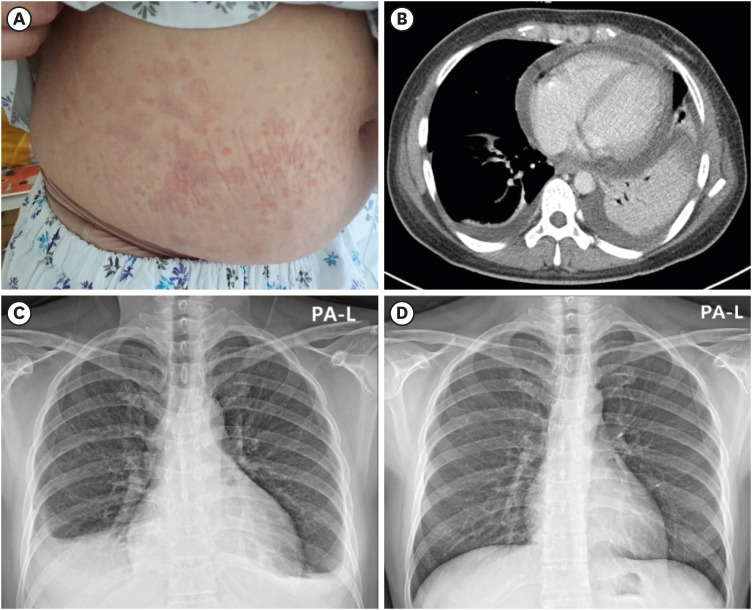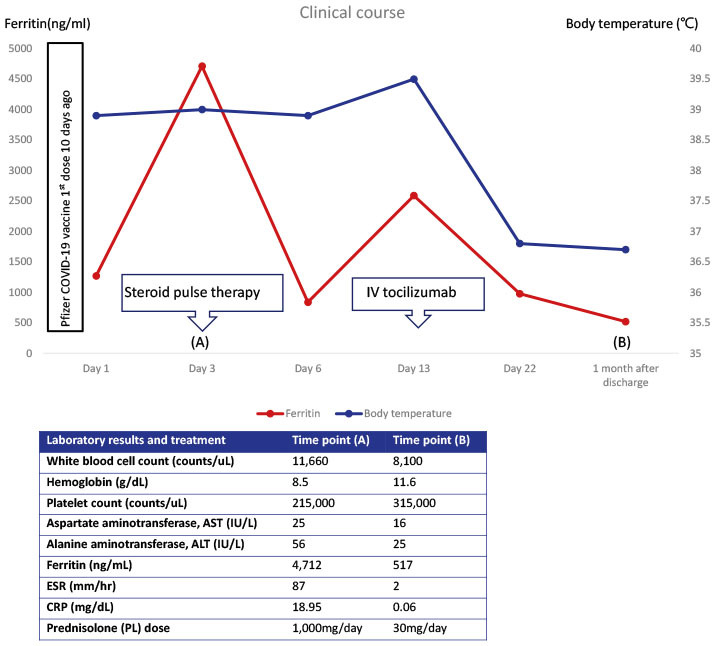1. Yamaguchi M, Ohta A, Tsunematsu T, Kasukawa R, Mizushima Y, Kashiwagi H, et al. Preliminary criteria for classification of adult Still’s disease. J Rheumatol. 1992; 19(3):424–430. PMID:
1578458.
2. Yamamoto S, Nishimura K, Yo K, Waki D, Murabe H, Yokota T. Flare-up of adult-onset Still’s disease after receiving a second dose of BNT162b2 COVID-19 mRNA vaccine. Clin Exp Rheumatol. 2021; 39:Suppl 132. (5):139–140.
3. Bamidis AD, Koehler P, di Cristanziano V, Rasche K, Demirel B, Bacher P, et al. First manifestation of adult-onset Still’s disease after COVID-19. Lancet Rheumatol. 2021; 3(5):e319–e321. PMID:
33817663.

4. Leone F, Cerasuolo PG, Bosello SL, Verardi L, Fiori E, Cocciolillo F, et al. Adult-onset Still’s disease following COVID-19 vaccination. Lancet Rheumatol. 2021; 3(10):e678–e680. PMID:
34316728.

5. Magliulo D, Narayan S, Ue F, Boulougoura A, Badlissi F. Adult-onset Still’s disease after mRNA COVID-19 vaccine. Lancet Rheumatol. 2021; 3(10):e680–e682. PMID:
34316726.

6. Feist E, Mitrovic S, Fautrel B. Mechanisms, biomarkers and targets for adult-onset Still’s disease. Nat Rev Rheumatol. 2018; 14(10):603–618. PMID:
30218025.

7. Yang L, Xie X, Tu Z, Fu J, Xu D, Zhou Y. The signal pathways and treatment of cytokine storm in COVID-19. Signal Transduct Target Ther. 2021; 6(1):255. PMID:
34234112.

8. Lustig Y, Sapir E, Regev-Yochay G, Cohen C, Fluss R, Olmer L, et al. BNT162b2 COVID-19 vaccine and correlates of humoral immune responses and dynamics: a prospective, single-centre, longitudinal cohort study in health-care workers. Lancet Respir Med. 2021; 9(9):999–1009. PMID:
34224675.

9. Grasland A, Le Maître F, Pouchot J, Hazera P, Bazin C, Vinceneux P. Adult-onset Still’s disease after hepatitis A and B vaccination? Rev Med Interne. 1998; 19(2):134–136. PMID:
9775130.
10. Yoshioka K, Fujimoto S, Oba H, Minami M, Aoki T. Onset of adult-onset Still’s disease following influenza vaccination. Mod Rheumatol. 2011; 21(4):432–435. PMID:
21327453.

11. Sato T, Takeo N, Matsuda-Hirose H, Abe K, Nishida H, Hatano Y. Adult-onset Still’s disease following pneumococcal vaccination. Eur J Dermatol. Forthcoming. 2021; DOI:
10.1684/ejd.2021.4102.

12. Berardicurti O, Ruscitti P, Ursini F, D’Andrea S, Ciaffi J, Meliconi R, et al. Mortality in tocilizumab-treated patients with COVID-19: a systematic review and meta-analysis. Clin Exp Rheumatol. 2020; 38(6):1247–1254. PMID:
33275094.
13. Ma Y, Wu M, Zhang X, Xia Q, Yang J, Xu S, et al. Efficacy and safety of tocilizumab with inhibition of interleukin-6 in adult-onset Still’s disease: a meta-analysis. Mod Rheumatol. 2018; 28(5):849–857. PMID:
29251027.






 PDF
PDF Citation
Citation Print
Print




 XML Download
XML Download